Target audience research allows you to better understand your potential customer(s) and their underlying pain points.
The more you drill down into your high-value audience groups through strategic market segmentation, the closer you are to your next sale.
Learn the ins and outs of target marketing with plenty of examples to inform your strategy.
- What Is a Target Audience?
- How a Target Audience Differs From a Buyer Persona
- How Psychographic and Demographic Data Informs Marketing Campaigns
- How To Analyze and Define Your Target Audience
- Do Target Audiences Vary by Channel?
- 3 B2B Target Audience Examples
- 3 B2C Target Audience Examples
What Is a Target Audience?
A target audience is a group of consumers within a predefined target market that has been identified as the best recipients for a particular marketing message. And a target market broadly describes B2C or B2B consumers who care about your product or service and, under the right conditions, are most likely to spend money with your company.
An audience is a segment within that market.
For example, the target market for an online bookkeeping tool might include businesses with over $500K in annual revenue.
So a target audience profile for our bookkeeping program might be technology stakeholders with influence on decision-makers at companies that haven’t reviewed their accounting software needs in over two years. It’s much more specific than our target market, which is important because we can craft content marketing collateral that speaks directly to the challenges and needs of this influential group.
To create effective messaging within your marketing campaigns, you first need to define your target audience.
When marketers try to appeal to the broadest possible audience for their products and services, they often end up feeling exhausted without much to show for their efforts. Their messaging seems inauthentic and doesn’t really resonate with anyone in particular.
To create effective messaging within your marketing campaigns, you first need to define your target audience. Doing so will help you engage key decision-makers and eventually convert them into loyal customers.
At this point, you might be asking, “Isn’t that just a buyer persona?” And while the two concepts are similar, they are distinct enough to warrant further discussion.
How a Target Audience Differs From a Buyer Persona
A buyer persona is a fictional character who represents one of your ideal customers. They have names, occupations, likes and dislikes, as well as challenges and ambitions.
While target audiences are valuable tools for many types of content marketing campaigns, buyer personas tend to be more useful in a B2B context, because they focus on challenges and business information. For example, a B2C company that sells protein bars would not need to create multiple personas, because people from many backgrounds and with varying job titles might purchase their products.
In a B2B context, targeting personas can be extremely valuable, especially when employing content marketing strategies. A SaaS company might create personas for each stakeholder involved in the buying process, for instance. An HR persona might be interested in blog content that addresses common pain points, while a CFO persona would be more interested in white papers with lots of data.
Personas aren’t entirely without value to B2C marketers, however. They can serve as useful guides when crafting messages to engage and inform consumers.
A persona typically includes:
- Personal information: Name, age and geographic location.
- Content preferences: Favorite channels, content formats, tone and style.
- Business background information: Job title, level of influence in decision making processes.
- Objectives: Measurable goals related to the persona’s job.
- Challenges: Frustrations and pain points standing in the way of the persona’s goals.
How Psychographic and Demographic Data Informs Marketing Campaigns
Your target audiences should be informed by both demographic and psychographic information. The former category describes your intended audience on a superficial level, while the latter describes their motivations.
- Demographics may include cursory information such as gender, age, income and marital status.
- Psychographics include personal interests, attitudes, values, desires and specific behaviors.
When defining and targeting an audience, demographics will only get you so far. For example, if you’re promoting a B2B SaaS solution, your specific audience may be made up of men and women ages 35-49 who earn more than $100,000 annually. That’s all good information to have, but it applies to too broad of a cohort.
Psychographic data for this specific audience could include: worrying about lost resources throughout a supply chain, wanting to eliminate redundancies, or being skeptical of flashy new technology.
Combined, demographic and psychographic information can help you fine-tune your audience targeting goals.
Combined, demographic and psychographic information can help you fine-tune your audience targeting goals. The challenge is where to find this data. Psychographic research may include interviewing existing clients, conducting polls and analyzing your site traffic.
How to Analyze and Define Your Target Audience
Defining the target audience for a particular marketing campaign requires data. Unfortunately, there isn’t a crystal ball that can tell you how to adjust your messages to bring in the right audience. But that’s not to say you can’t trust your gut.
You know your business better than anyone, so combine that experience with hard data to generate a market segment and target audience that is characteristically human, and also strategically defined by scientifically gathered data.

A Three-Step Approach To Defining A Target Audience
1. Conduct target customer research
Your business plan, content marketing strategy, professional experience and prior knowledge of your target customers will lay the foundation for your research. Compile all of your existing intelligence on your target market, and look for opportunities to learn more about it. For example, you might know that most of your customers are senior-level business people, but you may not know if they all have the same job title, or if they all consume content through the same channels.
To uncover key audience insights, use Google Analytics to drill down into your site traffic and perform a deep audience analysis. Custom audience reports can show you demographic and psychographic data, geographic locations as well as the types of technology your site visitors use.
2. Analyze the market
Once you know a little more about your target customers and have compared that data with your business process or goals, it’s time to get some context. Not only are you attempting to place the right messages in front of the right people at the right time, but you’re also competing with potentially thousands of other messages.
Review your competitors’ marketing efforts and business plans to better understand what you’re up against. Likewise, you’ll want to be aware of any other campaigns your business is currently running, as you don’t want to cannibalize your share of audience attention.
3. Define the audience
With hard data in tow and a thorough understanding of your audience’s interests, challenges and needs, it’s time to create a concise target audience to which you can direct your content marketing efforts.
Ask yourself these questions as you work to define your target audience:
- What problems does your product or service solve?
- Which demographic characteristics influence the decision-making process?
- Which psychographic traits impact content consumption?
- How does your audience prefer to engage with brands similar to yours?
- Is your audience segment large enough?
That last question is particularly important, because it will prevent you from sinking resources into ultra-niche campaigns with low ROI. Niche marketing is certainly a useful tactic, but your target audiences should represent a group large enough to reach through social and organic channels.
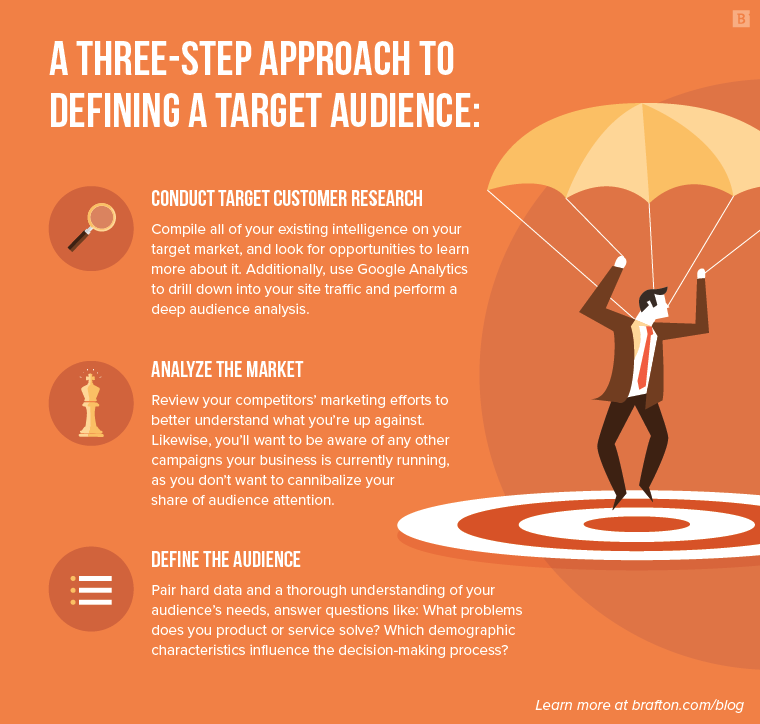
Do Target Audiences Vary by Channel?
Knowing your intended audience is only one half of the equation. The next step in the target audience analysis process is to determine where this group consumes content so you can develop an actionable marketing strategy.
Depending on the demographic and psychographic data you’ve collected, some channels will be more effective at engaging your intended audience than others. For instance, some decision-makers in a market segment may be more likely to open an email than to click on a social media ad.
Within channels, a specific audience may prefer unique platforms. B2B buyers are more inclined to seek out information on LinkedIn than Instagram, for example.
Subscribe to
The Content Marketer
Get weekly insights, advice and opinions about all things digital marketing.
Thank you for subscribing to The Content Marketer!
3 B2B Target Audience Examples
(Keep in mind the following custom audiences are meant to inform specific campaign messages! These companies may have different audience segments for other targeting efforts. Each example is based on a real client I’ve worked with.)
1. Bookkeeping SaaS Solution
Key demographics
- Age range: 35-49.
- Gender: 65% male, 35% female.
- Common job titles: Head of Digital, Senior Accountant, Chief Financial Officer.
Key psychographics
- Values job security.
- Likes to review all the data before making a decision.
- Striving for a better work-life balance.
- Skeptical of solutions that promise to solve all their problems.
Challenges
- Their current digital solution is showing its age.
- Current lack of third-party integration is slowing down internal processes.
- Boss/shareholder demands are making work stressful.
Preferred channels
- Email for first contact, then phone conversations.
- Browses social media platforms like LinkedIn, mostly looking for news.
Preferred content types
- Data-rich white papers.
- Case studies.
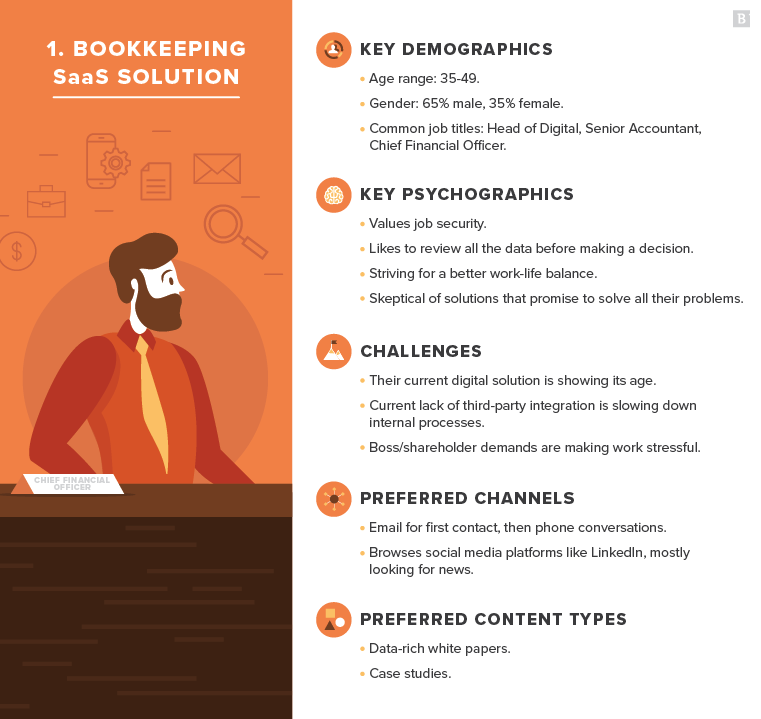
2. Business Travel Company
Key demographics
- Age range: 30-55.
- Gender: 70% female, 30% male.
- Common job titles: Procurement Officer, Travel Buyer, Supplier Relations Expert.
Key psychographics
- Values relationships when working with suppliers.
- Dislikes working on repetitive, mundane tasks.
- Is wary of handing off responsibilities to a third party.
Challenges
- Suppliers fail to deliver on promised rates.
- Doesn’t have enough data to make informed decisions.
- Not familiar with ground-level travel concerns.
Preferred channels
- Looks for answers via organic search.
- Communicates with other procurement professionals on social media platforms.
Preferred content types
- Easily digestible blog posts.
- Case studies.
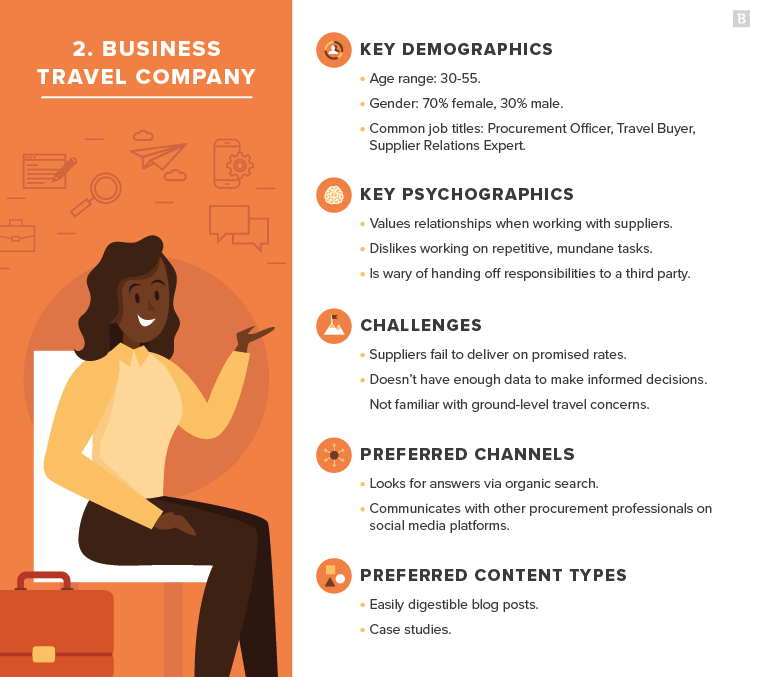
3. Facility Security Services
Key demographics
- Age range: 45-60.
- Gender: 80% male, 20% female.
- Common job titles: Facility Manager, Head of Security.
Key psychographics
- Doesn’t like drawn-out negotiations.
- Likes to be prepared for everything; gets nervous when things are uncertain.
- Prefers to get pitches from two or three companies before making a decision.
Challenges
- Needs to save costs, but isn’t willing to sacrifice quality of service.
- Needs a third-party supplier with technology integrations.
Preferred channels
- Email for marketing materials.
- Blogs and news sites for industry trends.
Preferred content types
- Articles.
- Data-rich infographics.
- Email newsletters.
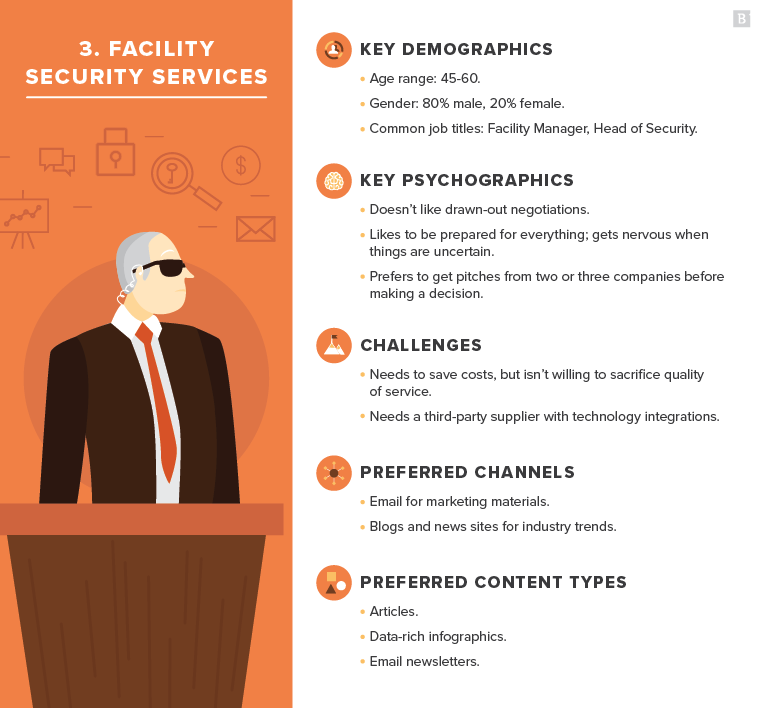
B2C Target Audience Examples
4. Athletic Shoes
Key demographics
- Age range: 18-29
- Gender: 60% male, 40% female
Key psychographics
- Wants to look stylish, but doesn’t like to follow trends.
- Looks up to sports figures.
- Strongly values friendships and community.
- Loyal to one or two athletic brands.
Challenges
- Finding athletic footwear that is both stylish and comfortable.
- Loves the look of designer sneakers, but can’t afford them.
Preferred channels
- Follows athletes and influencers on social media.
- Watches sponsored events on YouTube.
- Looks for exercise tips on Google.
Preferred content types
- Social media posts.
- Videos.
- Image-rich articles.
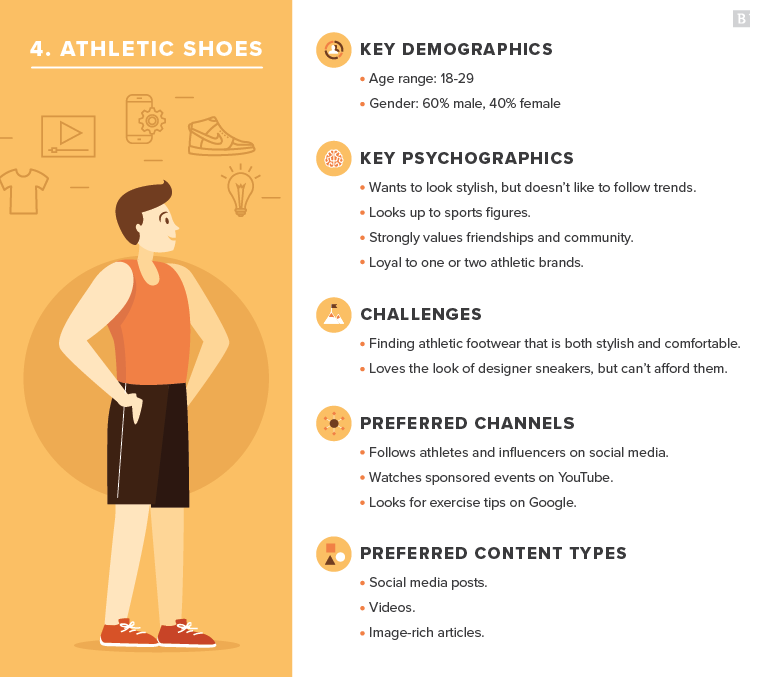
5. Organic Protein Bars
Key demographics
- Age range: 18-35.
- Gender: 50% female, 50% male.
Key psychographics
- Strives to eat food that is nutritious and sustainable, but isn’t always successful.
- Loves to hang out with friends in nature.
- Feels loyalty toward brands with values similar to their own.
Challenges
- Finds it difficult to eat healthy food when they’re busy.
- Has a limited food budget.
- Needs a protein source that is compact and easy to transport.
Preferred channels
- Follows nature photography accounts on Instagram.
- Watches supplement reviews on YouTube.
- Follows health gurus on Twitter.
Preferred content types
- Social media posts.
- Videos.
- Event marketing.
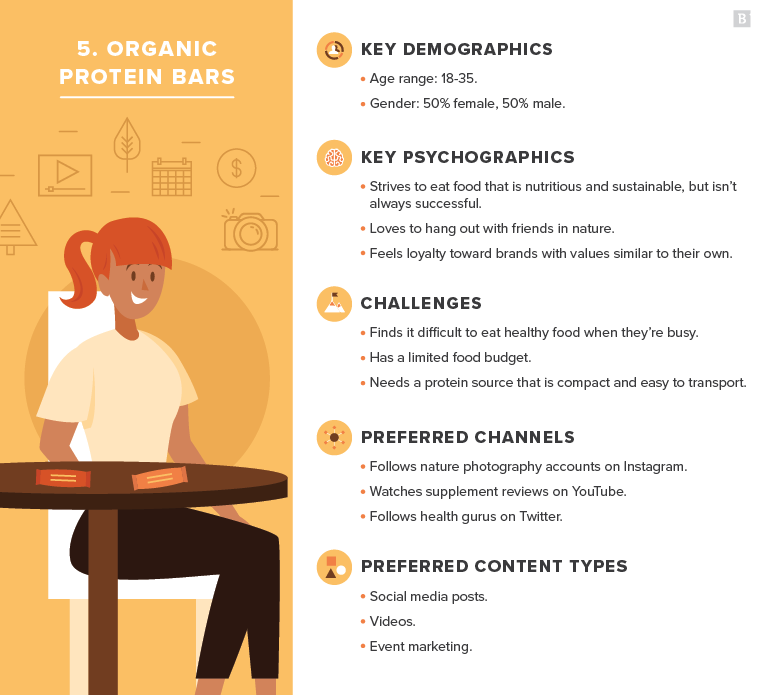
6. Credit Union Mortgage Products
Key demographics
- Age range: 25-39.
- Gender: 50% male, 50% female.
Key psychographics
- Enjoys spending time with friends and family at home.
- Tries to spend their money wisely, but isn’t always sure how to do that.
- Craves stability, but fears another economic recession.
Challenges
- Feels anxious every time they think about having a mortgage.
- Is thinking about mortgages for the first time ever.
- Unclear on the difference between a bank and a credit union.
Preferred channels
- Reads online news sites.
- Downloads how-to guides online.
- Watches home-hunting videos on YouTube.
Preferred content types
- Articles.
- eBooks.
- Videos.
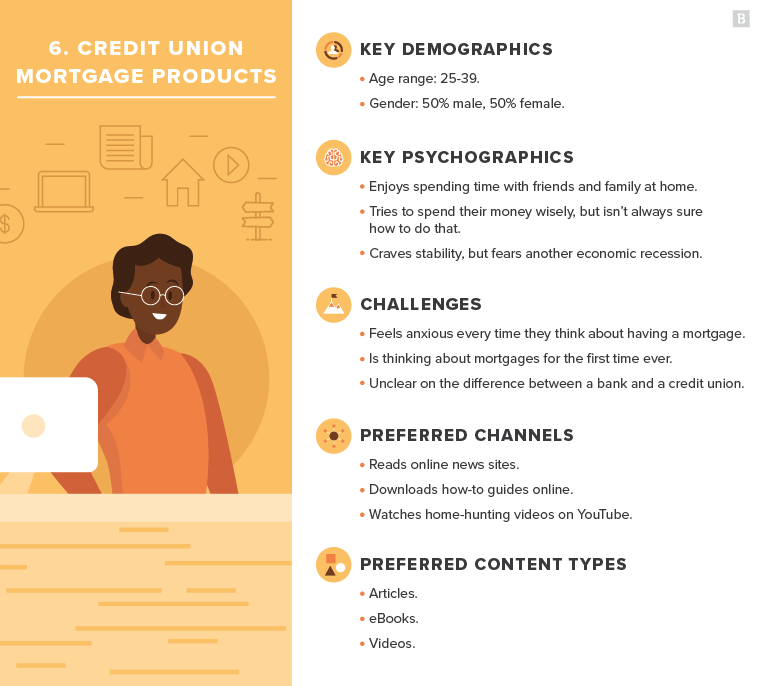
When you have well-defined, custom audiences informed by strong research, you can stop waiting for buyers to stumble upon your brand and start actively pursuing them with precise messaging.
Editor’s note: Updated November 2021.






